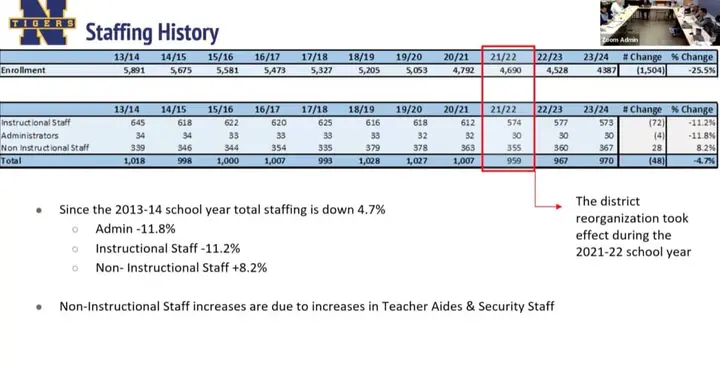Sneak peek: BOE’s upcoming meeting to focus on instructional portion of 2024-2025 budget

A recent meeting of the district’s financial planning board committee offered a preview of – and insight into – tomorrow’s board of education meeting, which will focus on the instructional portion of the proposed 2024-2025 budget.
As it stands, and using the current draft model of budgeted expenses, the district is showing a budget deficit of slightly over $3 million. Superintendent of Schools Dr. Dave Moyer has been straightforward in his recommendations about reducing that deficit, and presented at the March 7 financial planning board meeting numerous tax levy scenarios and options on how to balance the budget under each of them.
Current levy scenarios, as shown to the committee, range from 1.99% to 2.4% (this year’s maximum levy authority), representing an additional impact on individual homeowners from, on average, $163 to $196.
Scenarios also included the possible restoration of approximately $500,000 in state aid, though exact state aid numbers have not yet been received by the district. Bob Howard, assistant superintendent of business, said there’s a good likelihood the district’s state aid will increase by an additional $240,000 to $518,000.
All scenarios avoid increases to fund balance and reserves utilization.
Deficit reduction options, as recommended by Superintendent Moyer, to get to a balanced budget in the numerous tax levy scenarios (with state aid) include staffing attrition that would see the reduction of one elementary school librarian and 12.8 full-time employees, as well as one AIS reduction; a possible change in an attendance zone policy that would remove the option of transportation for some students attending, via a variance, in-district schools other than their homeschool; the removal of a placeholder in the current budget for an outside contractor to help with community engagement; and athletic display case additions that were done this fiscal year and have since been removed from the 2024-2025 budget.
Moyer is hoping that most, if not all, of the staffing adjustments can be done through attrition. “We will either be at zero or very, very close to zero in regards to real job loss,” he said, though he cautioned that, with the last of the retirement incentives in place for at least the next three years, the possibility of real job loss in the future should be taken into consideration.
Should the district not receive the anticipated state aid, other reduction considerations include a staffing job loss of one school counselor and a 10% cut in clubs and activities across the board, as well as a reduction in printing and mailing costs totaling $105,000. Different tax levy scenarios showed additional job loss, including that of up to two administrators and three counselors.
“The lower the levy, the more we will have to go into real job loss to balance our numbers,” Moyer said at the meeting. The district is currently reimagining some staff positions now in place, including instructional coordinators in the ITRT (Instructional Technology Resource Teacher) department, though making such changes would be a process and take time, said BOE President Larry Licopoli.
A staffing history overview was also presented last week, showing total staffing down 4.7% since the 2013-14 school year, including a reduction of 48 staff members following the districtwide reorganization that took place in 2021-2022.
“We have made strides in trying to readjust staffing, but that’s part of what we have to work on continually here over the next couple of years as part of an overall budget strategy,” Moyer said. Changes in staffing will likely result in class size increases in upper-level elementary school classes, Moyer said, though they will still be below the district’s targets (in the low- to mid-20s).
A “high level overview of the savings related to the district reorganization and resulting efficiencies,” will also be shared at tomorrow’s meeting, district officials told the Journal.
Another difficult but essential discussion, Moyer said, revolves around the rich offering of elective courses at the high school, some of which may be subject to cuts; those cuts would likely be based on course enrollment.
Questions regarding the relevancy of some courses would need to be answered, the superintendent said, as would the issue of low class numbers. While giving students varied opportunities has been a trademark of the district, it’s also an expensive model: “And you have to make a decision about the extent to which you’re willing to continue to support that kind of thing,” Moyer said. “In all likelihood, there will be some decisions that have to be made in future years where classes that have traditionally run might not run.”
Balancing the community’s interest in sustaining these programs with the budget realities of the district will continue to be discussed, Moyer said, as will the viability of student clubs and activities in all district buildings.
Moyer stressed that the numbers and scenarios presented to the financial committee were still being worked on and could “evolve” before Thursday’s BOE meeting and presentation. He has shared with principals and members of the teacher union executive board a “bigger picture overview” of the scenarios and reductions and understands that “every single person will have a personal interest in some aspect of this.”
“I’ve been trying to explain to people – in an effort to try and take as much emotion out of this, which is hard to do – that we’re trying to solve a math problem, we’re not trying to judge your contributions to the organization.”
Final budget numbers for the 2024-2025 school year are expected to be up for adoption by the board in mid-April.
The March 7 presentation to the financial planning board committee can be found here.
The board of education meeting to discuss the proposed 2024-2025 budget will take place tomorrow, March 14, in the William J. Brosnan building on Laurel Road at 7pm. The meeting will also be available for viewing on Zoom, here.
Don’t miss a story
Get the latest news delivered to your inbox.







